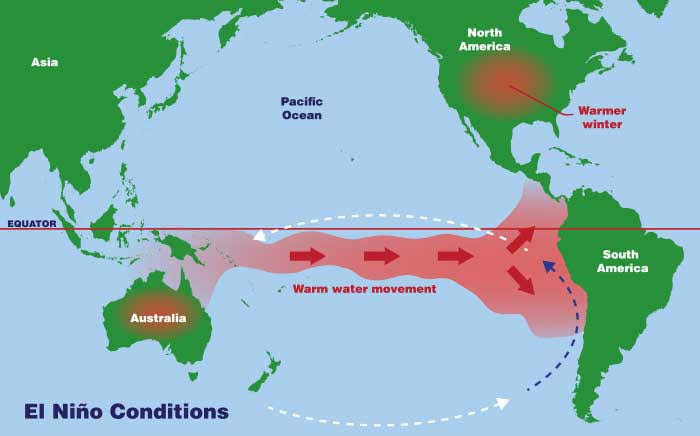Severe Storms, Droughts, Damages: Dire Predictions for Coming El Nino
What can we expect from the coming El Nino?
Credit, Concern Worldwide US
The National Aeronautics and Space Administration (NASA) spotted long ocean waves moving eastwards across the Pacific, heading towards the west coast of South America in March and April, waves just two to four inches high and hundreds of miles wide.
The World Meteorological Organisation (WMO) gave a new update after spotting the waves, predicting a 60 percent chance for a transition from ENSO-neutral to El Nino between May and June this year, increasing the possibility to about 70 percent between June and August, and 80 percent between July and September.
The National Oceanic and Atmospheric Administration’s (NOAA) modeling, having taken into consideration the spotting of the ocean waves, indicated a 62 percent chance for El Nino to develop sometimes between May and July, and predicting a 90 percent likelihood for El Nino to develop, saying it could happen as early as May.
With agencies such as NOAA, NASA, WTO, the India Meteorological Department (IMD) and others predicting a high chance of El Nino taking place, having spotted the ocean waves heading towards the west coast of South America, it seems certain EL Nino will make an appearance this year.
When experts analyzed the fall-out from the 1982-1983 El Nino, they found that it brought out a $4.1 trillion-loss in global income loss for five years, while the El Nino that took place between 1997 and 1998 cost the world about $5.7 trillion in income losses, with the following El Nino costing the world an even higher figure in income losses.
When experts analyzed the consequences from the 1982-1983 El Nino, they discovered that damages worth more than $13 billion happened to properties, between 1,300 to 2,000 deaths occurred over the phenomenon, with encephalitis outbreaks happening over the east coast of the United States through secondary effects providing a perfect weather for the growth of mosquitoes.
When experts analyzed the fall-out from the 1997-1998 El Nino, they discovered that an El Nino-related drought caused a cereal shortage of 3.5 million metric tons in Indonesia, made an estimated 16 percent of the world’s reef system to die, and temporarily warmed air temperatures by 1.5 degrees Celsius compared to the usual increase of 0.25 degrees Celsius associated with the event.
When experts analyze El Nino events, they associate global income losses running into trillions of dollars, as well as several billion dollars in damages to properties, and drastic rises in the air temperature, all reasons why an El-Nino in the next few months should be a cause for worry.
Unfortunately, expert predictions for disaster in the next El Nino event prove disturbing, as some of them predict that it could take a $3 trillion toll on the global economy, the estimates based on the damages of past events, added to forecasts pointing to a frightening occurrence, when warm weather patterns re-emerge.
According to experts, global economies could pay as much as $84 trillion by the end of the century, as climate change exacerbates future El-Nino events.
Also, some experts predict that the next El Nino could trigger a situation where global temperatures go beyond 1.5 degrees Celsius above pre-industrial levels for at least one of the years within 2023 and 2027, with a range of 1.1 to 1.8 degrees Celsius forecasted for each of the five years, which is higher than the 1850 to 1900 average.
According to experts, the world could pay through an expected sea level rise of 10 to 30 inches, putting at least ten million people at the risk of coastal storms and heating, while heat waves expose 14 percent of the world population to extreme temperatures once every five years.
Some experts predict that the next El Nino could trigger a situation where South Africa and India experience drought and extreme heat, with the overall monsoon rainfall deficit in the latter country as much as nine percent, and the year a catastrophic period for coral bleaching, as severe as the one that took place between 2014 and 2019.
According to experts, the world could pay through destructive bushfires and drier, hotter weather, especially as 18 of the 27 El Nino years brought widespread winter and spring droughts since 1900 at a place such as Australia, and similar devastation in other parts of the globe.
From expert predictions therefore, the global economy faces trillions of dollars in losses with an El Nino exacerbated by climate change, global temperatures above 1.5 degrees Celsius in at least one year between 2023 and 2027, as well as drought and extreme heat in many parts of the world.
In addition, sea level rise could be expected over the new climate change-exacerbated El Nino, with the globe paying through bush fires and drier, hotter weather, as well as annual surface temperature rises.
Throughout, rising temperatures from climate change fuel the impact of the El Nino event, putting it at the verge of taking a $3 trillion toll on the global economy in the foreseeable future. Rising sea levels occasioned by climate change increase the severity of El Nino, putting the lives of ten million people living on the coastal areas in jeopardy. Throughout, the combination of climate change-influenced rising temperatures and sea levels makes the severity of El Nino to increase. To mitigate the effects of El Nino, a way has to be found to tackle the issue of climate change, and this can only be done through the reduction in the usage of fossil fuel.
What to Eat
Vegan food from India, Credit, Sukhis.com




